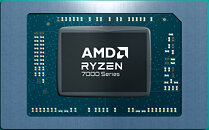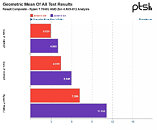T0@st
News Editor
- Joined
- Mar 7, 2023
- Messages
- 3,328 (3.83/day)
- Location
- South East, UK
| System Name | The TPU Typewriter |
|---|---|
| Processor | AMD Ryzen 5 5600 (non-X) |
| Motherboard | GIGABYTE B550M DS3H Micro ATX |
| Cooling | DeepCool AS500 |
| Memory | Kingston Fury Renegade RGB 32 GB (2 x 16 GB) DDR4-3600 CL16 |
| Video Card(s) | PowerColor Radeon RX 7800 XT 16 GB Hellhound OC |
| Storage | Samsung 980 Pro 1 TB M.2-2280 PCIe 4.0 X4 NVME SSD |
| Display(s) | Lenovo Legion Y27q-20 27" QHD IPS monitor |
| Case | GameMax Spark M-ATX (re-badged Jonsbo D30) |
| Audio Device(s) | FiiO K7 Desktop DAC/Amp + Philips Fidelio X3 headphones, or ARTTI T10 Planar IEMs |
| Power Supply | ADATA XPG CORE Reactor 650 W 80+ Gold ATX |
| Mouse | Roccat Kone Pro Air |
| Keyboard | Cooler Master MasterKeys Pro L |
| Software | Windows 10 64-bit Home Edition |
Intel decided to drop the relatively new AVX-512 instruction set for laptop/mobile platforms when it was discovered that it would not work in conjunction with their E-core designs. Alder Lake was the last generation to (semi) support these sets thanks to P-cores agreeing to play nice, albeit with the efficiency side of proceedings disabled (via BIOS settings). Intel chose to fuse off AVX-512 support in production circa early 2022, with AMD picking up the slack soon after and working on the integration of AVX-512 into Zen 4 CPU architecture. The Ryzen 7040 series is the only current generation mobile platform that offers AVX-512 support. Phoronix decided to benchmark a Ryzen 7 7840U against older Intel i7-1165G7 (Tiger Lake) and i7-1065G7 (Ice Lake) SoCs in AVX-512-based workloads.
Team Red's debut foray into AVX-512 was surprisingly performant according to Phoronix's test results—the Ryzen 7 7840U did very well for itself. It outperformed the 1165G7 by 46%, and the older 1065G7 by an impressive 63%. The Ryzen 7 APU was found to attain the highest performance gain with AVX-512 enabled—a 54% performance margin over operating with AVX-512 disabled. In comparison Phoronix found that: "the i7-1165G7 Tiger Lake impact came in at 34% with these AVX-512-heavy benchmarks or 35% with the i7-1065G7 Ice Lake SoC for that generation where AVX-512 on Intel laptops became common."



Phoronix concluded: "Overall the AVX-512 usage across the AMD Zen 4 product spectrum has been great. The efficient AVX-512 usage on the mobile/laptop processors is great for those developers wanting to work and test code from their device, if wanting to use any AI / deep learning software for edge computing or related use-cases, or just enjoying other AVX-512 optimized software from CPU-based renderers to other creator software packages. Those wishing to go through this round of data I collected for Phoenix / Tiger Lake / Ice Lake can find it here with all the individual per-test metrics."
View at TechPowerUp Main Site | Source
Team Red's debut foray into AVX-512 was surprisingly performant according to Phoronix's test results—the Ryzen 7 7840U did very well for itself. It outperformed the 1165G7 by 46%, and the older 1065G7 by an impressive 63%. The Ryzen 7 APU was found to attain the highest performance gain with AVX-512 enabled—a 54% performance margin over operating with AVX-512 disabled. In comparison Phoronix found that: "the i7-1165G7 Tiger Lake impact came in at 34% with these AVX-512-heavy benchmarks or 35% with the i7-1065G7 Ice Lake SoC for that generation where AVX-512 on Intel laptops became common."



Phoronix concluded: "Overall the AVX-512 usage across the AMD Zen 4 product spectrum has been great. The efficient AVX-512 usage on the mobile/laptop processors is great for those developers wanting to work and test code from their device, if wanting to use any AI / deep learning software for edge computing or related use-cases, or just enjoying other AVX-512 optimized software from CPU-based renderers to other creator software packages. Those wishing to go through this round of data I collected for Phoenix / Tiger Lake / Ice Lake can find it here with all the individual per-test metrics."
View at TechPowerUp Main Site | Source



